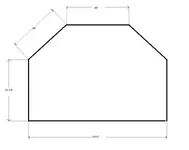B
bishop55
Member
Hi folks,
I need some advice. I know the value and the complexity of room treatment, and I would like make changes to improve my drum recordings. I looked at lots of posts, but would like specific advice that consider my current restraints. I am recording in my finished attic space with drywall knee walls and a carpeted floor (linoleum tiles underneath). I have included an image with the measurements. I have around 20 or so panels of oc703 that a friend gave me. These panels are not framed, and are covered in some weird thin, plastic/vinyl type covering with eyelets for hanging. Not ideal, but they were cheap.
As you can see from the image, the room has challenges, and I'm not expecting it to sound great for recording drums, but I'd like to do the best I can with what I have.
I tried recording with the recorderman method and had mixed results. One day it sounded fine, the next it was boxy, and I suspect I had some phase issues because the cymbals kept sounding like they were moving in the stereo field in spots, very weird.
I'm using two at3035's for overheads and I have the kit close-miced as well.
Right mow I have the drums positioned out a bit from one corner of the room, caddy cornered with the kick extending about to the middle of the room. I have 2 panels on the knee walls behind it, 2 on the sloping walls over it, 3 on the ceiling and 4 more on the sloped and knee walls across from it.
Straingely, perhaps, I am getting a better sound with the 3035's spread out in a sort of wide overhead position.
Sorry for the length of the post, and I would appreciate any suggestions.
I need some advice. I know the value and the complexity of room treatment, and I would like make changes to improve my drum recordings. I looked at lots of posts, but would like specific advice that consider my current restraints. I am recording in my finished attic space with drywall knee walls and a carpeted floor (linoleum tiles underneath). I have included an image with the measurements. I have around 20 or so panels of oc703 that a friend gave me. These panels are not framed, and are covered in some weird thin, plastic/vinyl type covering with eyelets for hanging. Not ideal, but they were cheap.
As you can see from the image, the room has challenges, and I'm not expecting it to sound great for recording drums, but I'd like to do the best I can with what I have.
I tried recording with the recorderman method and had mixed results. One day it sounded fine, the next it was boxy, and I suspect I had some phase issues because the cymbals kept sounding like they were moving in the stereo field in spots, very weird.
I'm using two at3035's for overheads and I have the kit close-miced as well.
Right mow I have the drums positioned out a bit from one corner of the room, caddy cornered with the kick extending about to the middle of the room. I have 2 panels on the knee walls behind it, 2 on the sloping walls over it, 3 on the ceiling and 4 more on the sloped and knee walls across from it.
Straingely, perhaps, I am getting a better sound with the 3035's spread out in a sort of wide overhead position.
Sorry for the length of the post, and I would appreciate any suggestions.

